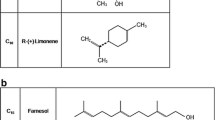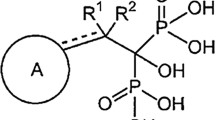Abstract
Bisphosphonates such as alendronate have been developed as antiresorptive agents capable of treating diseases related to bone remodeling. In the present study, we examined the effect of alendronate on the healing of acetic acid-induced gastric ulcers in rats and investigated the mechanism involved in this action both in vivo and in vitro using the rat gastric epithelial cell line (RGM1). Acetic acid-induced gastric ulcers healed spontaneously, with up-regulation of COX-2/prostaglandin E2 production as well as expression of vascular endothelium-derived growth factor (VEGF) and basic fibroblast growth factor (bFGF) in ulcerated mucosa. The healing of ulcers was impaired by indomethacin (2 mg/kg, s.c.) or alendronate (60 mg/kg, p.o.) given once daily for 7 days, starting 3 days after acid application. Indomethacin, but not alendronate, inhibited mucosal prostaglandin E2 production. Alendronate as well as indomethacin decreased the protein expression of both VEGF and bFGF in ulcerated mucosa, resulting in a reduction of angiogenesis in the ulcer base. Supplementation of recombinant bFGF significantly reverted the delay in ulcer healing caused by alendronate. On the other hand, the size of cell-free areas in RGM1 cells in vitro decreased with time after wound induction, and this process was promoted by epidermal growth factor (EGF; 10 ng/ml). Co-incubation with alendronate (1 mM) did not affect the spontaneous healing but significantly suppressed the accelerated wound healing caused by EGF. These results suggest that alendronate impairs the healing of gastric ulcers in rats, and this effect may be related to down-regulation of VEGF and bFGF, the important growth factors for vascularization/granulation, as well as suppression of the stimulatory action of EGF on epithelial proliferation/migration.








Similar content being viewed by others
References
Lowe CE, Depew TW, Vanner SJ, Paterson WG, Meddings JB (2000) Upper gastrointestinal toxicity of alendronate. Am J Gastroenterol 95:634–640
Iseri SO, Sener G, Yuksel M, Contuk G, Cetinel S, Gedik N, Yegen BC (2005) Ghrelin against alendronate-induced gastric damage in rats. J Endocrinol 187:399–406
Blank MA, Ems BL, Gibson GW, Myers WR, Berman SK, Phipps RJ, Smith PN (1997) Nonclinical model for assessing gastric effects of bisphosphonates. Dig Dis Sci 42:281–288
Wallace JL, Dicay M, McKnight W, Bastaki S, Blank MA (1999) N-Bisphosphonates cause gastric epithelial injury independent of effects on the microcirculation. Aliment Pharmacol Ther 13:1675–1682
Russell RG, Croucher PI, Roger MJ (1999) Bisphosphonates: pharmacology, mechanism of action and clinical uses. Osteoporosis Int 9:S66–S80
Lichtenberger LM, Romeo JJ, Gibson GW, Blank MA (2000) Effect of bisphosphonates on surface hydrophobicity and phosphatidylcholine concentration of rodent gastric mucosa. Dig Dis Sci 45:1792–1801
Luckman SP, Hughes DE, Coxon EP, Graham R, Russell G, Rogers MJ (1998) Nitrogen-containing bisphosphonates inhibit the mevalonate pathway and prevent posttranslational prenylation of GTP-binding protein, including rats. J Bone Miner Res 13:581–589
Marshall JK, Rainsford KD, James C, Hunt RH (2000) A randomized controlled trials to assess alendronate-associated injury of the gastrointestinal tract. Aliment Pharmacol Ther 14:1451–1457
Kanatsu K, Aihara E, Okayama M, Kato S, Takeuchi K (2004) Mucosal irritative and healing impairment action of risedronate in rat stomachs: comparison with alendronate. J Gastroenterol Hepatol 19:512–520
Elliot SN, McKnight W, Davies NM, MacNaughton WK, Wallace JL (1998) Alendronate induces gastric injury and delays ulcer healing in rodents. Life Sci 62:77–91
Okabe S, Roth JLA, Pfeiffer CJ (1971) A method for experimental, penetrating gastric and duodenal ulcers in rats. Observations on normal healing. Am J Dig Dis 16:277–284
Szabo S, Folkman J, Vattay P, Morales RE, Pinkus GS, Kato K (1994) Accelerated healing of duodenal ulcers by oral administration of mutein of fibroblast growth factor in rats. Gastroenterology 106:1106–1111
Futaki N, Takahashi S, Yokoyama M, Arai I, Higuchi S, Otomo S (1994) NS-398, a new antiinflammatory agent, selectively inhibits prostaglandin G/H synthase/cyclo-oxygenase (COX-2) activity in vitro. Prostaglandins 47:55–59
Tso JY, Sun X-H, Kao T-H, Reece KS, Wu R (1985) Isolation and characterization of rat and human glyceraldehyde-3-phosphate dehydrogenase cDNAs: genomic complexity and molecular evolution of the gene. Nucleic Acids Res 13:2485–2502
Feng L, Sun W, Xia Y, Tang WW, Chanmugam P, Soyoola E, Wilson CB, Hwang D (1993) Cloning two isoforms of rat cyclooxygenase: differential regulation of their expression. Arch Biochem Biophys 307:361–368
Laemmli UK (1970) Cleavage of structural proteins during assembly of the head of bacteriophage T4. Nature 227:680–685
Watanabe S, Wang X, Hirose M, Oide H, Kitamura T, Miwa H, Miyazaki A, Sato N (1996) Platelet–derived growth factor accelerated gastric epithelial restoration in a rabbit cultured cell model. Gastroenterology 110:775–779
Keisari Y (1992) A colorimetric microtiter assay for the quantitation of cytokine activity on adherent cells in tissue culture. J Immunol Methods 146:151–161
Mizuno H, Sakamoto C, Matsuda K, Wada K, Uchida T, Noguchi H, Akamatsu T, Kasuga M (1997) Induction of cyclooxygenase 2 in gastric mucosal lesions and its inhibition by the specific antagonist delays healing in mice. Gastroenterology 112:387–397
Brzozowski T, Konturek PC, Konturek SJ (2001) Classic NSAID and selective cyclooxygenase (COX)-1 and COX-2 inhibitors in healing of chronic gastric ulcers. Microsc Res Tech 53:343–353
Araki H, Komoike Y, Matsumoto M, Tanaka A, Takeuchi K (2002) Healing of duodenal ulcers is not impaired by indomethacin or rofecoxib, the selective COX-2 inhibitor, in rats. Digestion 66:145–153
Amagase K, Yokota M, Tsukimi Y, Okabe S (2003) Characterization of “unhealed gastric ulcers” produced with chronic exposure of acetic acid ulcers to indomethacin in rats. J Physiol Pharmacol 54:349–360
Tarnawski A (2005) Cellular and molecular mechanisms of gastrointestinal ulcer healing. Dig Dis Sci 50:S24–S33
Tarnawski A (1993) Cellular mechanisms of gastric ulcer healing. In: Domschke W, Konturek SJ (eds) The stomach. Springer, New York, pp 177–192
Tarnawski AS, Jones MK (1998) The role of epidermal growth factor (EGF) and its receptor in mucosal protection, adaptation to injury, and ulcer healing: involvement of EGF-R signal transduction pathways. J Clin Gastroenterol 27:S12–S20
Bornfeldt KE, Raines EW, Graves LM, Skinner MP, Krebs EG, Ross R (1995) Platelet–derived growth factor. Distinct signal transduction pathways associated with migration versus proliferation. Ann N Y Acad Sci 766:416–430
Hase S, Nakazawa S, Tsukamoto Y, Segawa K (1989) Effects of prednisolone and human epidermal growth factor on angiogenesis in granulation tissue of gastric ulcer induced by acetic acid. Digestion 42:135–142
Pai R, Szabo IL, Giap AQ, Kawanaka H, Tarnawski AS (2001) Nonsteroidal anti–inflammatory drugs inhibit re-epithelialization of wounded gastric monolayers by interfering with actin, Src, FAK, and tensin signaling. Life Sci 69:3055–3071
Szabo S, Folkman J, Vincze A, Sandor ZS, Gombos Z (1997) Modulation of vascular factors by VEGF/VPF (vascular endothelial cell growth factor/vascular permeability factor) is sufficient for chronic ulcer healing and acute gastroprotection. Gastroenterology 112:A303
Szabo S, Vincze A, Sandor ZS, Gombos Z (1998) Vascular approach to gastroduodenal ulceration: new studies with endothelins and VEGF. Dig Dis Sci 43:40S–45S
Ernst H, Konturek PC, Hahn EG, Stosiek HP, Brzozowski T, Konturek SJ (2001) Effect of local injection with basic fibroblast growth factor (BFGF) and neutralizing antibody to BFGF on gastric ulcer healing, gastric secretion, angiogenesis and gastric blood flow. J Physiol Pharmacol 52:377–390
Miura S, Tatsuguchi A, Wada K, Takeyama H, Shinji Y, Hiratsuka T, Futagami S, Miyake K, Gudis K, Mizokami Y, Matsuoka T, Sakamoto C (2004) Cyclooxygenase-2-regulated vascular endothelial growth factor release in gastric fibroblasts. Am J Physiol 287:G444–G451
Tarnawski A (2000) Molecular mechanism of ulcer healing. Drug News Perspect 158–168
Taupin D, Wu DC, Jeon WK, Devaney K, Wang TC, Podolsky DK (1999) The trefoil gene family are coordinately expressed immediate-early genes: EGF receptor- and MAP kinase-dependent interregulation. J Clin Invest 103:R31–R38
Halter F, Barbezat GO, Van Hoorn-Hickman R, Van Hoorn WA (1980) Healing dynamics of traumatic gastric mucosal defects in normal and hyperacid stomach. Dig Dis Sci 25:916–920
Wang JY, Nagai H, Okabe S (1990) Effect of omeprazole on delayed healing of acetic acid-induced gastric ulcers in rats. Jpn J Pharmacol 54:82–85
Satoh H, Inatomi N, Nagaya H, Inada I, Nohara A, Nakamura N, Maki Y (1989) Antisecretory and antiulcer activities of a novel proton pump inhibitor AG-1749 in dogs and rats. J Pharmacol Exp Ther 248:806–815
Blank MA, Ems BL, Gibson GW, Myers WR, Berman SK, Phipps RJ, Smith PN (1997) Nonclinical model for assessing gastric effects of bisphosphonates. Dig Dis Sci 42:281–288
Author information
Authors and Affiliations
Corresponding author
Rights and permissions
About this article
Cite this article
Amagase, K., Hayashi, S., Nishikawa, K. et al. Impairment of Gastric Ulcer Healing by Alendronate, a Nitrogen-Containing Bisphosphonate, in Rats. Dig Dis Sci 52, 1879–1889 (2007). https://doi.org/10.1007/s10620-007-9769-5
Received:
Accepted:
Published:
Issue Date:
DOI: https://doi.org/10.1007/s10620-007-9769-5




